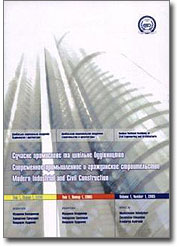Structural considerations of energy efficiency of translucent enclosing structures
Abstract: The paper considers the problem of energy translucent walling by selecting the optimal constructive decision nodes window (door) to block non-transparent part of the wall. The basic criteria for energy efficiency, which is necessary to optimize. These consist of: resistance to heat brought translucent (opaque) enclosure design, the temperature difference between inside air temperature and reduced temperature of the inner surface of wall enclosing structure, the minimum temperature of the inner surface of the linear coefficient of heat transfer. These design principles to ensure the selected criteria indicators. Research conducted for the nodal connections window structure on the basis of PVC profiles of Veka Softline 70 AD and fifteen types of constructive external opaque wall construction. For the linear rate of heat transfer coefficient defined the basic principles of the estimated assessment. According to the results of the studies identified some of the features and patterns that arise in assessing the translucent walling the specified criteria.
Keywords: translucent fencing design, energy efficiency, linear coefficient of heat transfer window node connection, temperature field.
Pages: 243-250.
For citation:
For citation: Belous, A. N.; Kolesnyk, Ye. S. Structural considerations of energy efficiency of translucent enclosing structures. – Text : electronic. – In: <em>Modern Industrial and Civil Construction</em>. – 2011. – Vol. 7, N 4. – Р. 243-250. – URL: https://donnasa.ru/publish_house/journals/spgs/2011-4/06_belous_kolesnik.pdf (date of access: 04.04.2025). – ISSN 1993-3495.

Vol. 7, N 4 (2011)
Journal: Modern Industrial and Civil Construction
Publish house: Donbas National Academy of Civil Engineering and Architecture
Journal: Modern Industrial and Civil Construction
Publish house: Donbas National Academy of Civil Engineering and Architecture
